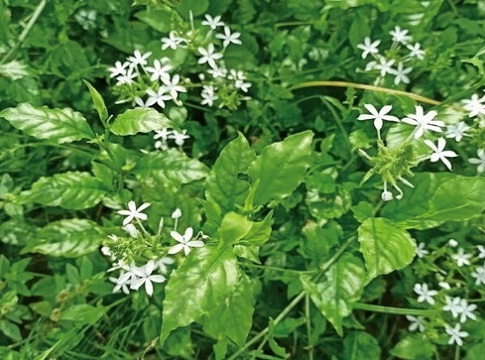Nikhil Prasad Fact checked by:Thailand Medical News Team Apr 05, 2025 2 weeks, 6 days, 11 hours, 30 minutes ago
Medical News: Ancient Herb Compound Shows Modern Promise in Fighting Cancer and Other Diseases
Indian Researchers from Osmania University, Aditya Degree & P.G. College, Savitribai Phule Pune University, Mangalayatan University-Jabalpur, and Veeranari Chakali Ilamma Women’s University have compiled a comprehensive review on plumbagin - a powerful plant-derived compound with extensive health benefits, especially in cancer treatment. Plumbagin is found in limited species such as those in the Plumbaginaceae family and carnivorous plants like Drosera and Nepenthes, which are increasingly being harvested unsustainably for pharmaceutical use.
 Plumbagin from Medicinal Plants Could Be the Next Big Anticancer Breakthrough
Plumbagin from Medicinal Plants Could Be the Next Big Anticancer Breakthrough
This
Medical News report will explore how scientists are now pushing forward with innovative biotechnological approaches to produce plumbagin more efficiently while protecting natural habitats.
What is Plumbagin and Why is It Important
Plumbagin is a bright yellow pigment belonging to a class of compounds called naphthoquinones. It has been recognized for its broad medicinal potential, including antioxidant, antibacterial, antifungal, anti-inflammatory, and even neuroprotective activities. However, its most exciting role is as a potent anticancer agent. It has demonstrated effectiveness against multiple cancers including breast, brain, liver, esophageal, lung, prostate, and pancreatic cancers.
The way plumbagin works is by targeting and disrupting several cellular pathways that cancer cells rely on to survive and grow. These include pathways such as PI3K/AKT/mTOR and STAT3, which are central to tumor proliferation and resistance to treatment. Additionally, plumbagin helps trigger oxidative stress inside cancer cells, damaging their DNA and pushing them toward self-destruction, while sparing healthy cells in many cases.
From Roots to Labs Finding Better Ways to Produce Plumbagin
Because most of the plumbagin comes from plant roots, particularly Plumbago rosea and Plumbago zeylanica, traditional harvesting methods involve uprooting entire plants. This practice threatens the survival of these species and leads to habitat destruction. To combat this, scientists are developing in vitro methods to produce plumbagin using plant tissue cultures, callus, suspensions, and most importantly, hairy root cultures that can continuously produce the compound in controlled environments.
Hairy root systems, when treated with substances like jasmonic acid or exposed to specific wavelengths of LED light, have shown the ability to produce significantly higher amounts of plumbagin. Researchers are also experimenting with precursor feeding (like L-alanine or sodium acetate) and cell aggregate optimization techniques to enhance yields even further.
One of the most promising breakthroughs involves the use of bioreactors and in situ extraction techniques, where plumbagin is absorbed into a res
in directly from the culture medium, allowing continuous harvesting without harming the cells. In one such setup, researchers reported an astonishing increase in plumbagin content - up to 92.13 mg/g of dry cell weight.
Tackling Bioavailability Issues with Nanotechnology
Despite plumbagin’s powerful effects, its poor water solubility and short bioavailability have limited its use in clinical settings. However, new delivery systems are being tested, such as nanoemulsions and plumbagin-loaded silver nanoparticles, to improve absorption and therapeutic action. These formulations are already showing promise in preclinical models, especially for prostate and pancreatic cancers.
Resensitizing Resistant Tumors and Targeting Copper in Cancer Cells
A unique discovery about plumbagin is its ability to re-sensitize cancer cells that have become resistant to chemotherapy or radiation. In fact, it can enhance the effectiveness of existing drugs like paclitaxel. Even more intriguing, plumbagin exploits the copper content within tumor cells, creating oxidative stress that selectively kills cancer cells while sparing normal tissue.
Conclusion
Plumbagin, once an obscure plant pigment used in traditional medicine, is now emerging as a multipurpose powerhouse in the fight against cancer and other chronic diseases. Its mechanisms - ranging from DNA damage via oxidative stress to blocking key signaling pathways - make it a uniquely versatile agent. Scientists are working around the clock to overcome production and solubility barriers using cutting-edge biotechnology and nanotechnology. As more clinical trials begin and delivery systems improve, plumbagin may soon step into the spotlight as a next-generation anticancer compound. Its low toxicity to healthy cells and ability to target drug-resistant cancers could revolutionize cancer therapy in the years to come.
The study findings were published in the peer reviewed journal: Molecules.
https://www.mdpi.com/1420-3049/30/7/1618
For the latest Cancer News, keep on logging to Thailand
Medical News.
Read Also:
https://www.thailandmedical.news/news/herbs-and-phytochemicals-anticancer-potential-and-molecular-targets-of-the-phytochemical-pristimerin-in-human-cancers
https://www.thailandmedical.news/news/medicinal-mushrooms-as-potential-therapy-for-lung-cancer
https://www.thailandmedical.news/news/herbs-and-phytochemicals-halodule-uninervis-a-new-hope-in-breast-cancer-treatment
https://www.thailandmedical.news/articles/herbs-and-phytochemicals
https://www.thailandmedical.news/articles/cancer
https://www.thailandmedical.news/pages/thailand_doctors_listings
